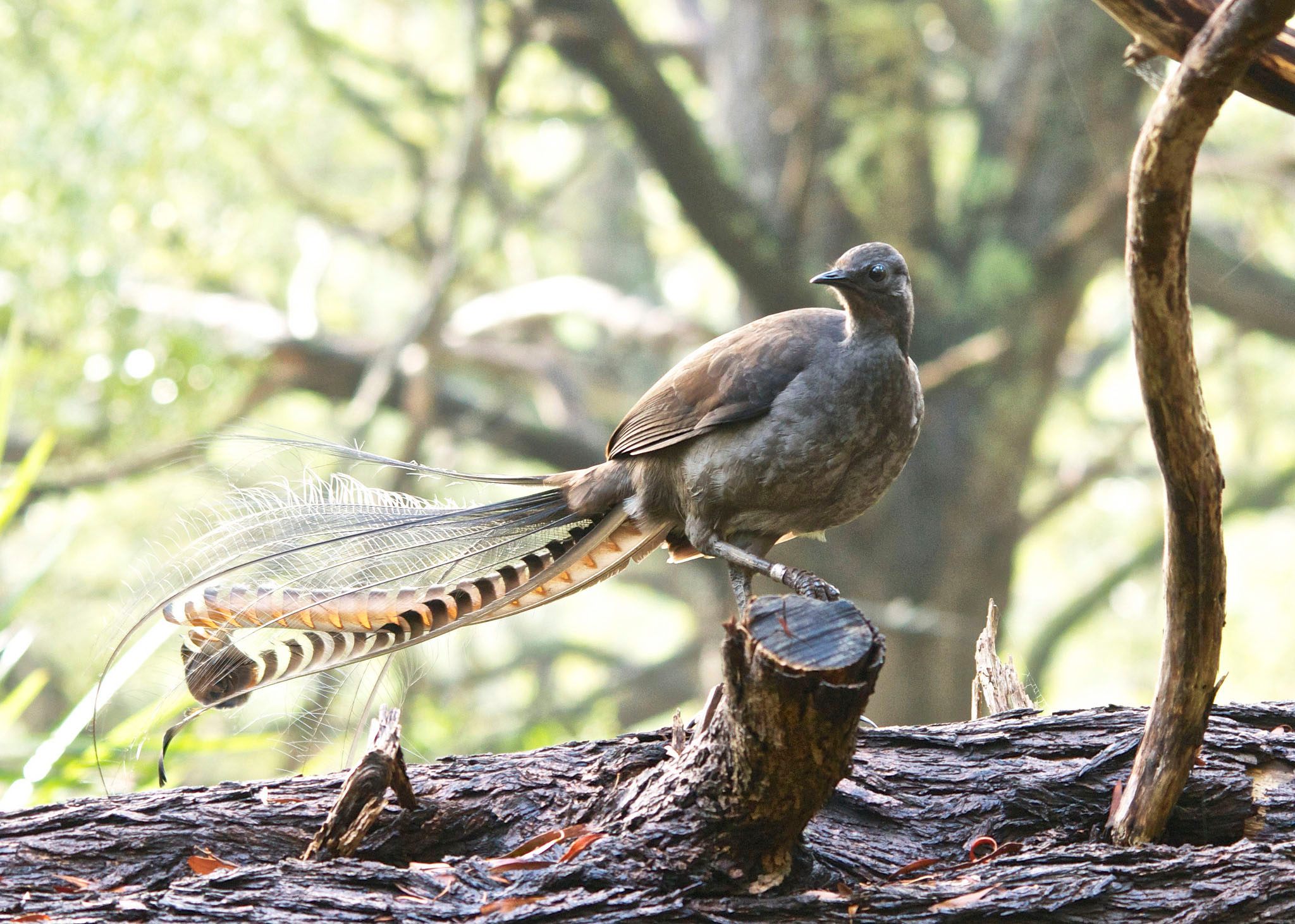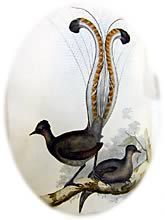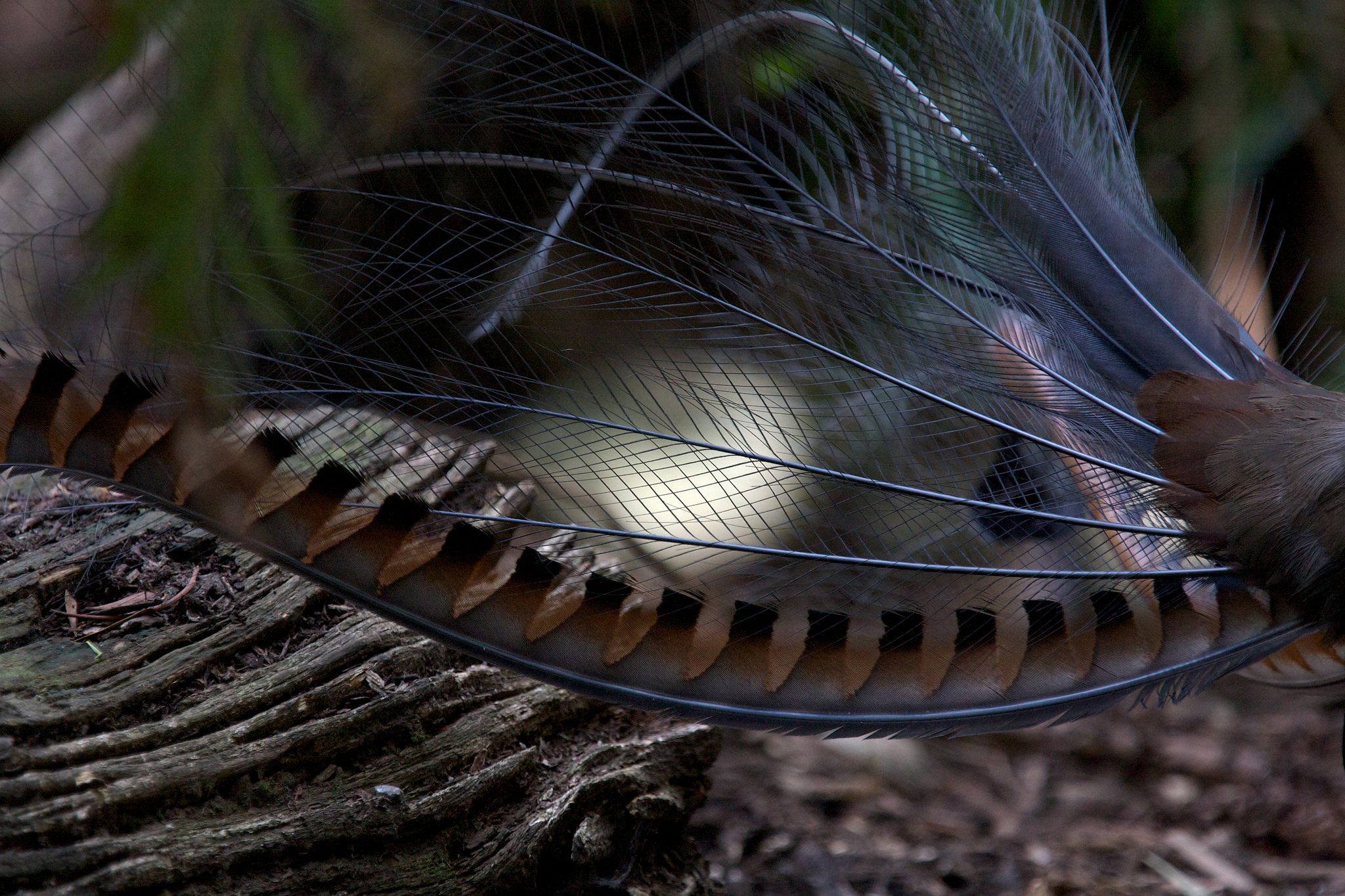The Strange Bird That Mimics Chainsaws, Car Horns and Human Voices

A male Superb Lyrebird. (Photo: Brian Ralphs/ flickr)
A small crowd gathered around a bird in the home of Mrs. Edith Wilkinson. His feathers stretched out, the bird opened his beak and sang out in the low voice of the kookaburra–then the magpie, the cockatoo, and even the “tooting of motor horns” before performing a two-step dance. Mrs. Wilkinson made friends with the bird, James, over a course of a year and was now proving her sanity to peers, or so goes the account in the 1930 book Lore of the Lyrebird by Ambrose Pratt.
Stories about these birds can be found again and again. The lyrebird’s plumes are not as colorful as a peacock’s, and they may not soar above trees for onlookers below, but this bird’s voice and dancing abilities have captivated humans for thousands of years.
Part of the genus Menura, the ground-dwelling lyrebird could be either of two species; the superb lyrebird and Albert’s lyrebird. Both birds are brown, pheasant-like, and inhabit the lush forests of south eastern Australia and walk the forest floor, often dashing out of sight when people approach. The superb lyrebird’s long tail inspired its English name in the 1800s, when a taxidermist at the British Museum incorrectly guessed at the bird’s tail, and artistically arranged it to curl like a lyre, later inspiring a John Gould painting with the same attributes. Albert’s lyrebird, named for England’s Prince Albert, lacks the long feathers, but most people are less impressed with their tails than this bird’s highly versatile voice.
Chook, the lyrebird who lived until 2011 at the Adelaide Zoo in southern Australia, became famous in Sir David Attenborough’s installment for BBC wildlife and on YouTube for mimicking chainsaws, hammers, cameras, and power drills. Nova, the superb lyrebird at Healesville Sanctuary similarly copied human noises, including car alarms and human speech.
While these birds’ skills are impressive, it doesn’t necessarily mean birds in the wild will pick up on man-made sounds readily if they aren’t common in the bird’s habitat–but as a bird hand-raised in captivity, Chook was instinctually drawing from his environment to develop the most complex song he could.

John Gould’s 1848 only partially-accurate drawing of a Lyrebird. (Photo: Public Domain/WikiCommons)
There are plenty of accounts about lyrebirds drawing from man-made sounds, however. Vicki Powys, Hollis Taylor and Carol Probets tried to uncover one story of the “flute lyrebirds” that inhabit Australia’s New England Tablelands, and published their investigation in the journal Environmental Humanities. As the story goes, in the 1920s, a lyrebird was raised in captivity in a house with a flute player who practiced a song called “The Mosquito Dance.” The bird was eventually released, fluttering into the Australian wilderness and introducing flute sounds to nearby lyrebirds. A woman named Martha Manns claimed to record these birds in the 1930s. In 1973, Norman Robinson recorded a group of lyrebirds in New South Wales after a national park ranger, Neville Fenton, noticed the birds sounded very similar to classical flute. While the veracity of this tale is yet to be (and may never be) confirmed, the recordings do sound notably flute-like.
Lyrebirds’ voices pick up where the mockingbird left off; they are able to mimic sounds of other birds and animals so well, and build such a repertoire of noises, that people may be fooled into believing they’re listening to several species–they can even call out in a few different bird voices at once. These birds have been known to imitate hundreds of other bird species. They sing the most during their mating season, the Australian winter months of June and July.
“We are not yet sure what physical attributes of lyrebirds allow them to imitate a diverse array of sounds,” says Dr. Anastasia H. Dalziell, an ornithologist at Cornell University who has studied mimicry in birds and the superb lyrebird extensively. “We suspect that lyrebirds have evolved a specialized syrinx (the songbird equivalent to our larynx) that allows them to vocally imitate a diverse array of sounds, while other songbirds probably have syrinxes optimized for their species-specific songs.”
While more research is necessary, lyrebirds may also have more of an ability to copy, learn, and remember complex strings of sounds than other birds–possibly learning them from other lyrebirds in a given area or from older generations.
Aboriginal stories, gathered by David Unaipon at the turn of the century, point to a rich history of lyrebird reverence. In these stories that explain the creation of the physical world, often called Tjukurrpa, or Dreamings, the lyrebird is seen as a vital influence on nature, teaching the frog how to talk and guiding human characters with its voice.

A close-up of the Lyrebird’s tail feathers. (Photo: Sascha Wenninger/flickr)
As part of the Australian forest ecosystem, lyrebirds do play a vital role, and may even naturally prevent wildfires, according to research by Daniel Nugent and other ornithologists. “Lyrebirds have quite a visible effect on the forest floor,” says Dalzeil. “Lyrebirds have big feet and feed by digging in the ground and demolishing rotting logs, so as to churn up worms and other invertebrates which they eat.” The removal of extra refuse on the forest floor means there is less fuel for wildfires. “After a lyrebird has been through, the forest floor can look like it has been ploughed,” she adds.
Those reports of people hearing lyrebirds in the wild mimicking chainsaws, would indicate, if true, that this was one of the sounds being heard most often by the birds–something that could harm the nearly-threatened Albert’s lyrebird along with the forest ecosystem.
While many birds mimic sounds, or have glorious feathers and complex dances, Dalzeil attests that “no other species puts these things all together like the lyrebirds do.” Lyrebirds are notoriously discreet when they aren’t singing and dancing on mounds of dirt in the forest, so you may not catch a glimpse in the wild right away. But if you’re walking in the bush of Australia and hear a bizarre mix of various avian creatures, you might just be listening to a single, mesmerizing bird.

















Follow us on Twitter to get the latest on the world's hidden wonders.
Like us on Facebook to get the latest on the world's hidden wonders.
Follow us on Twitter Like us on Facebook